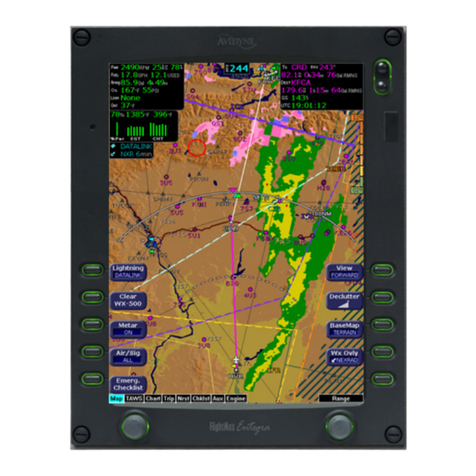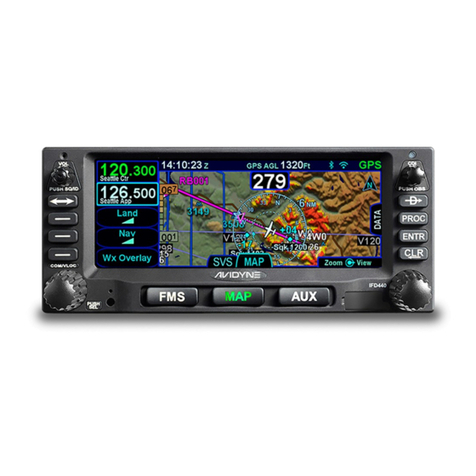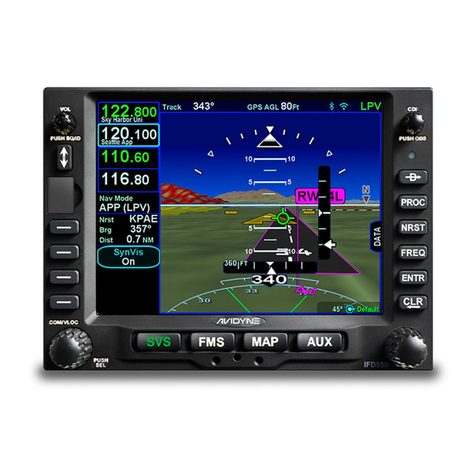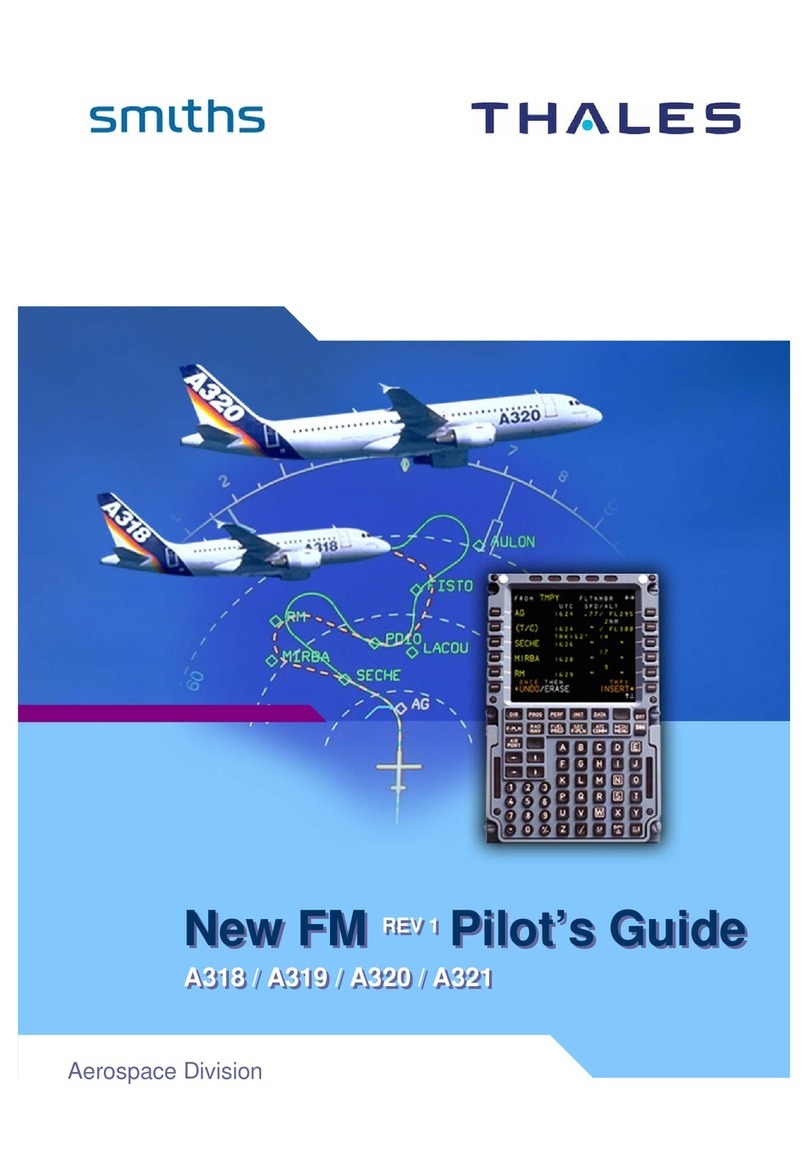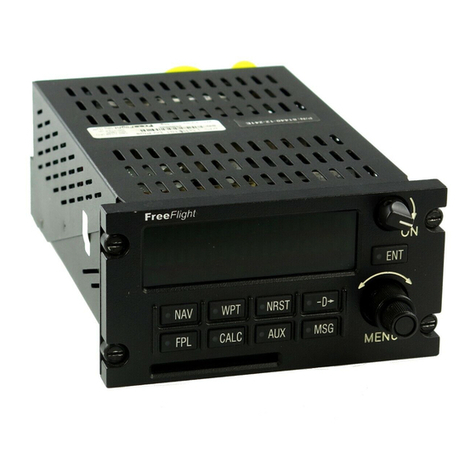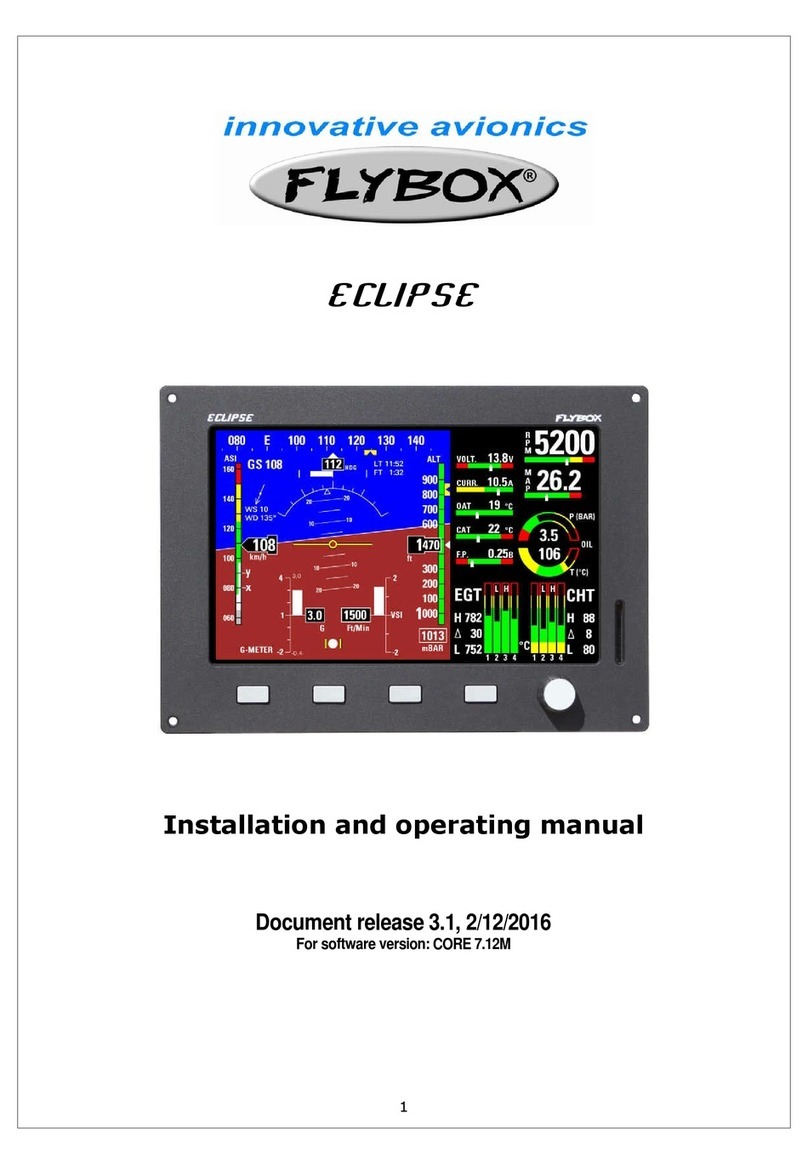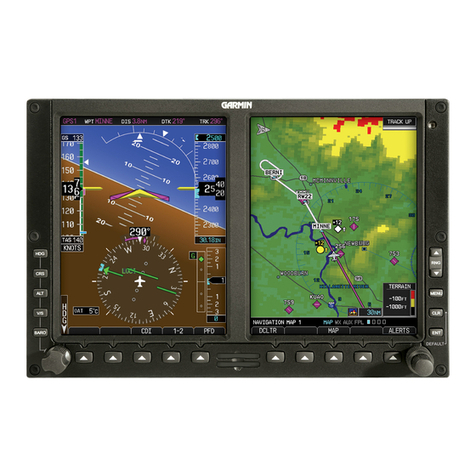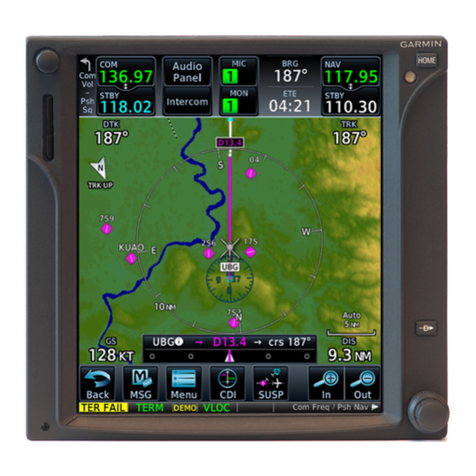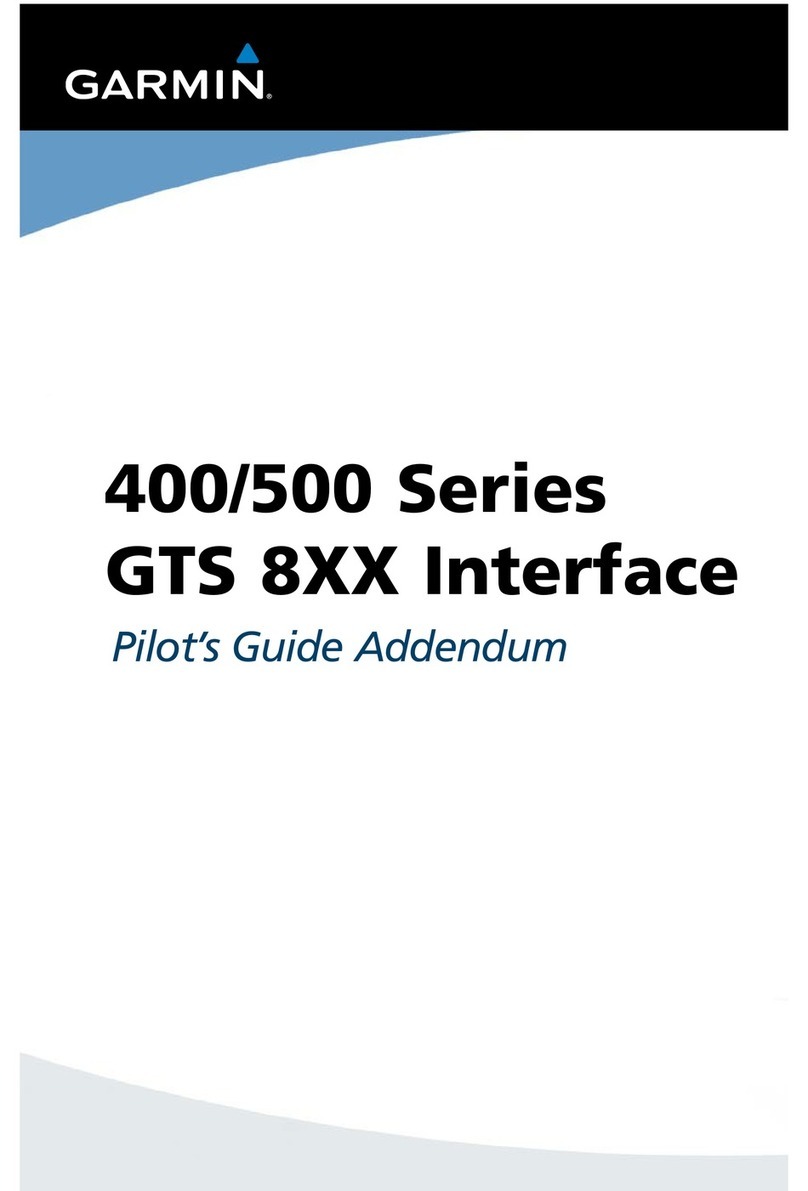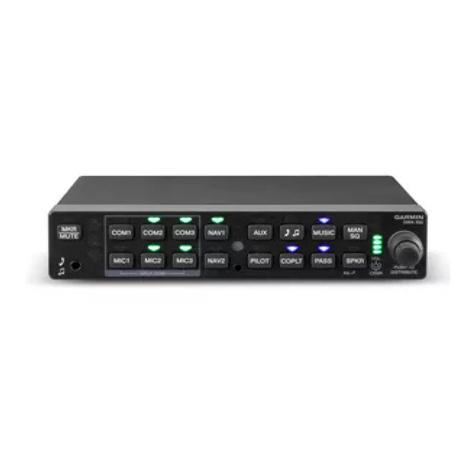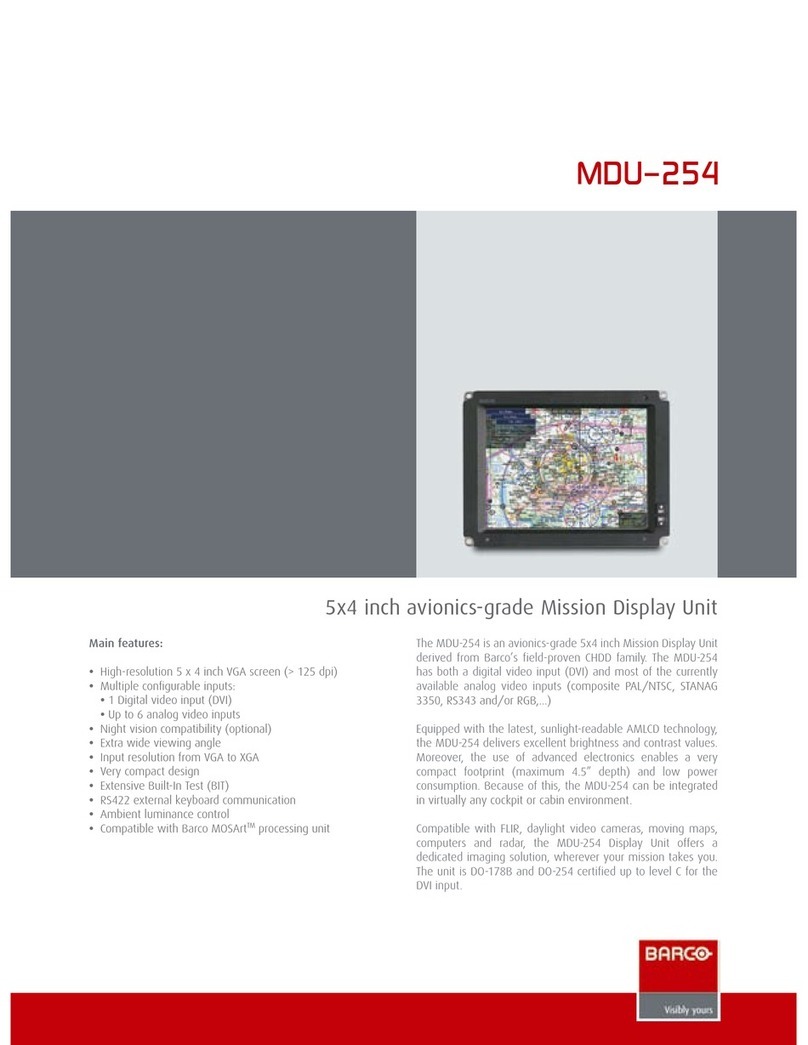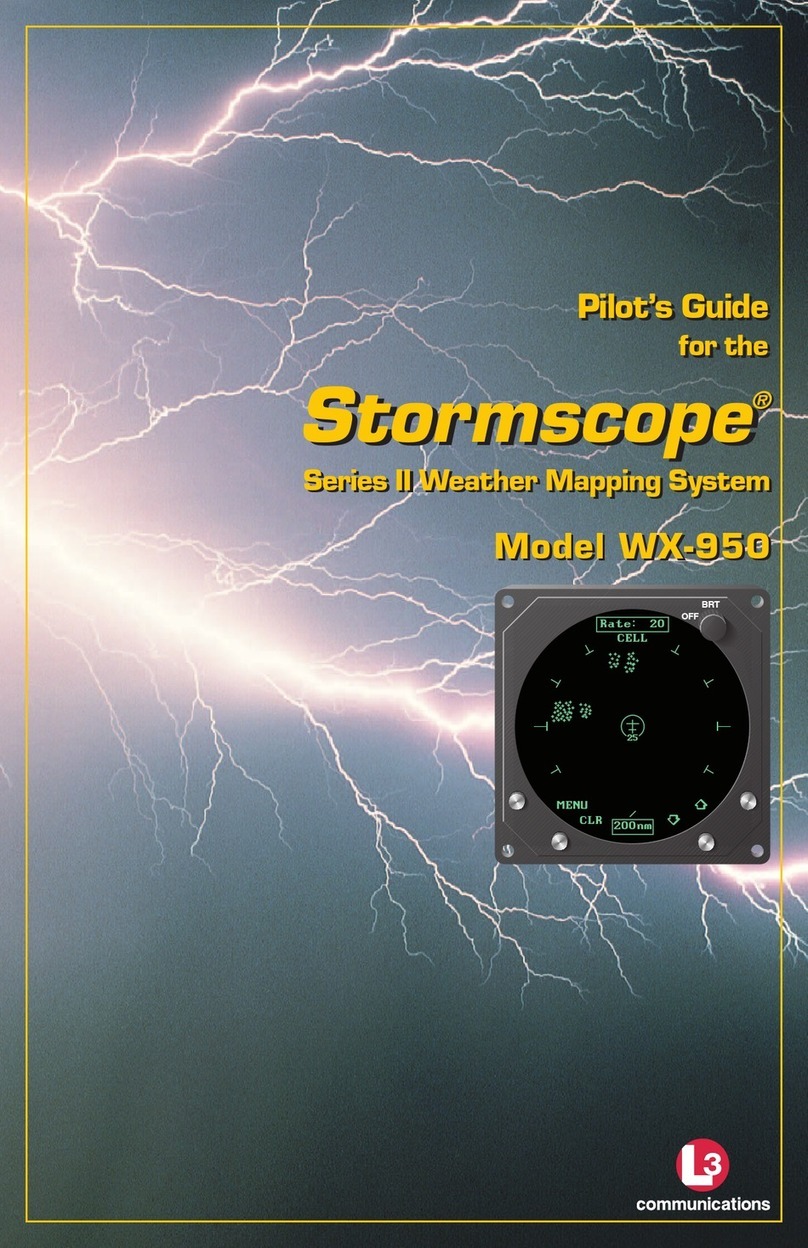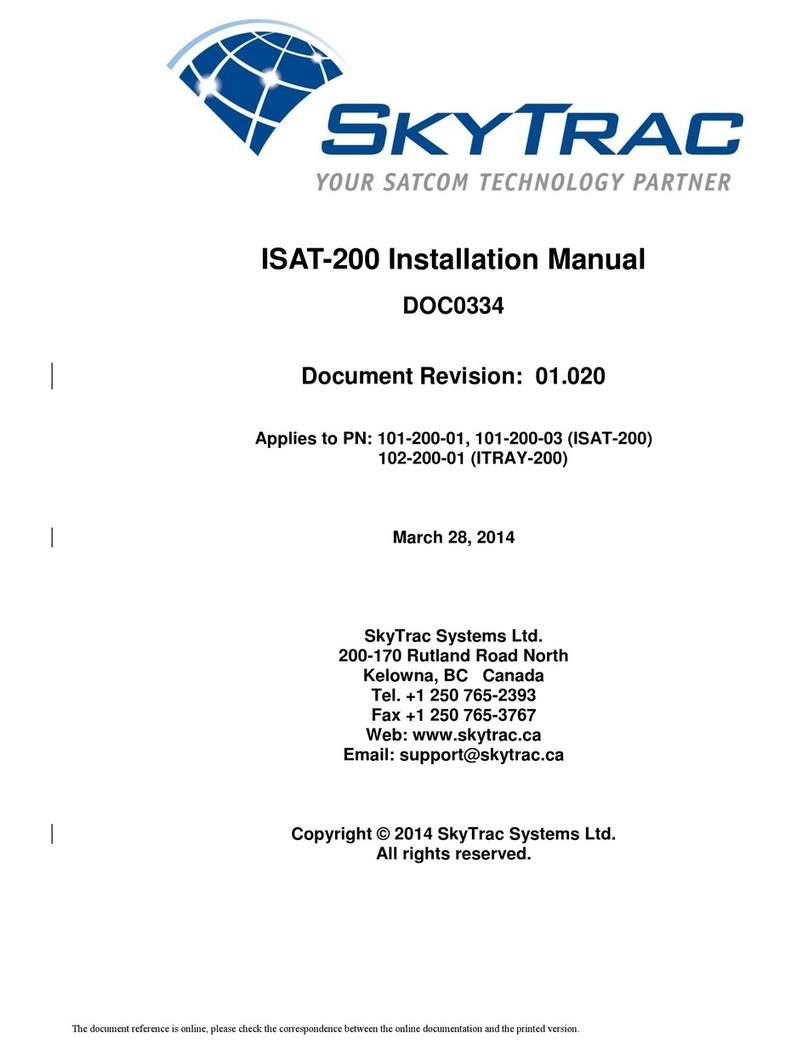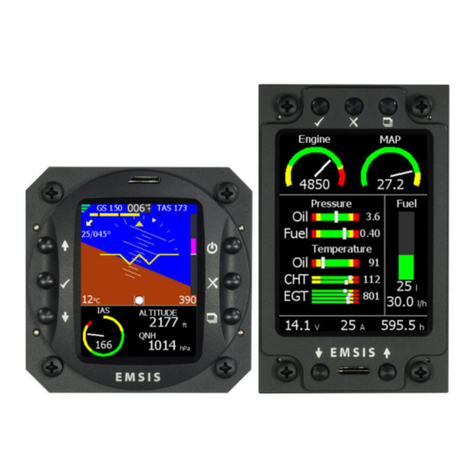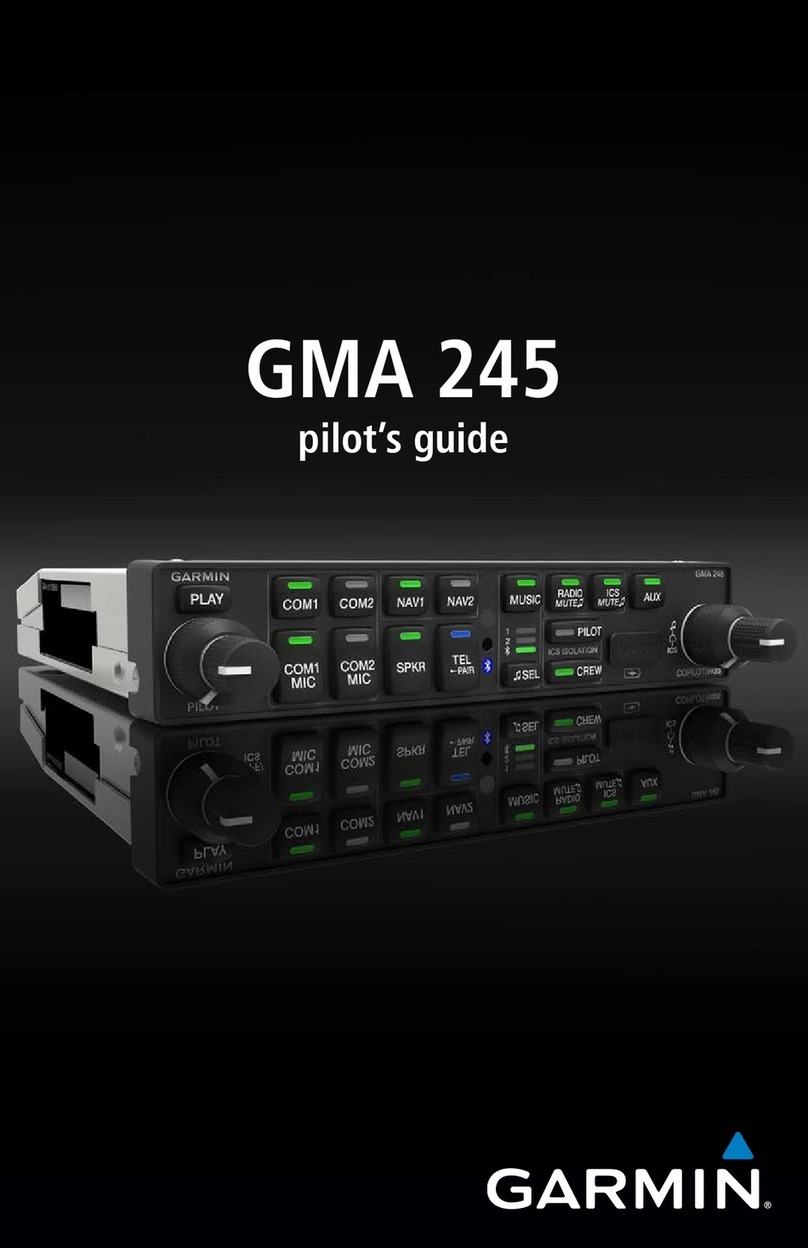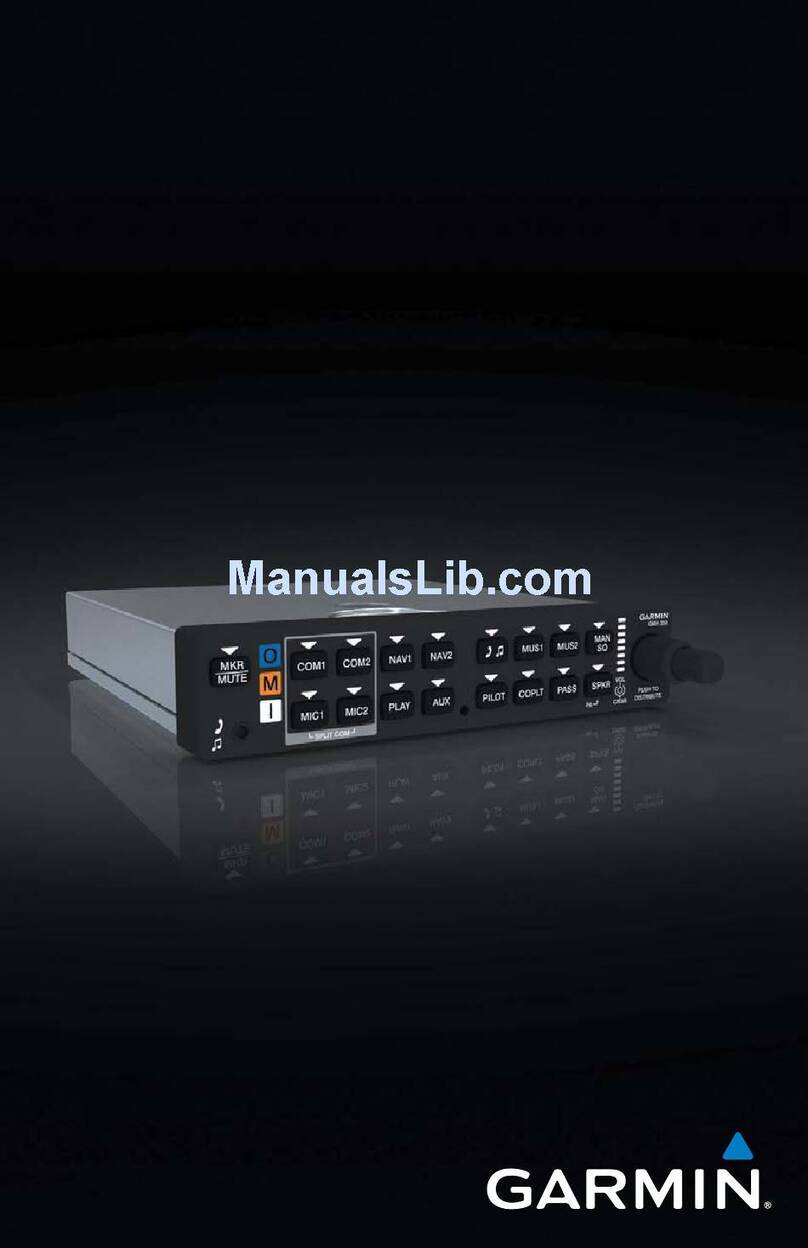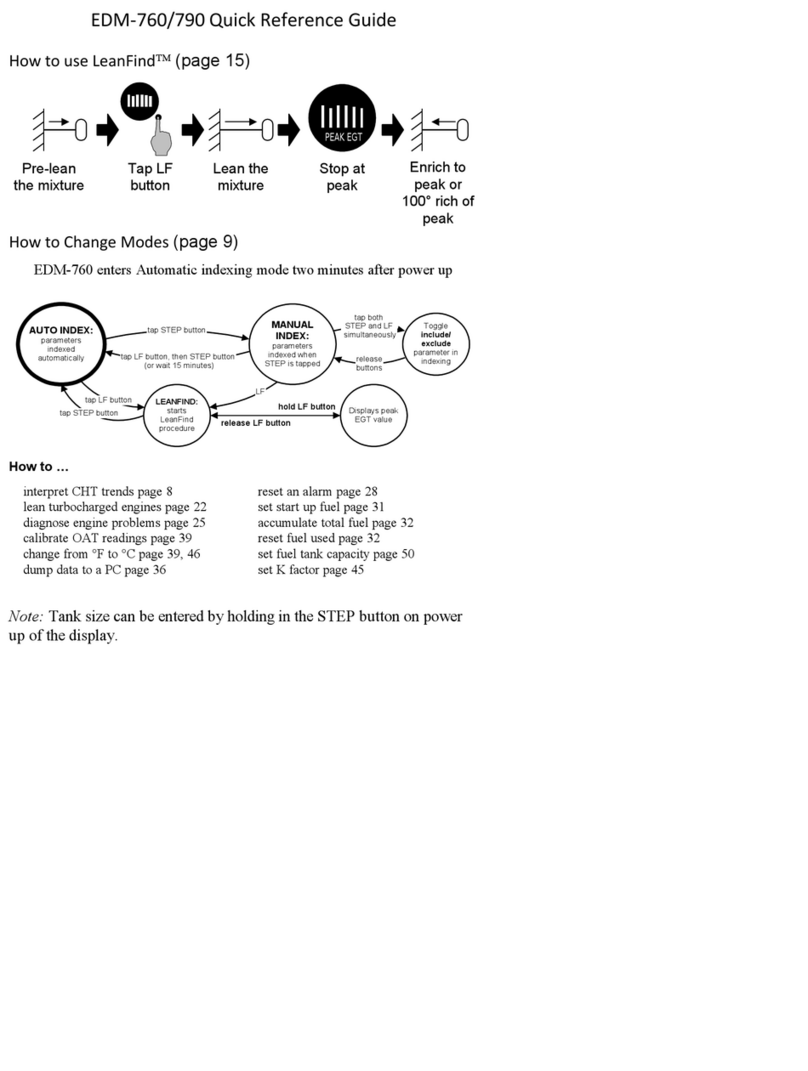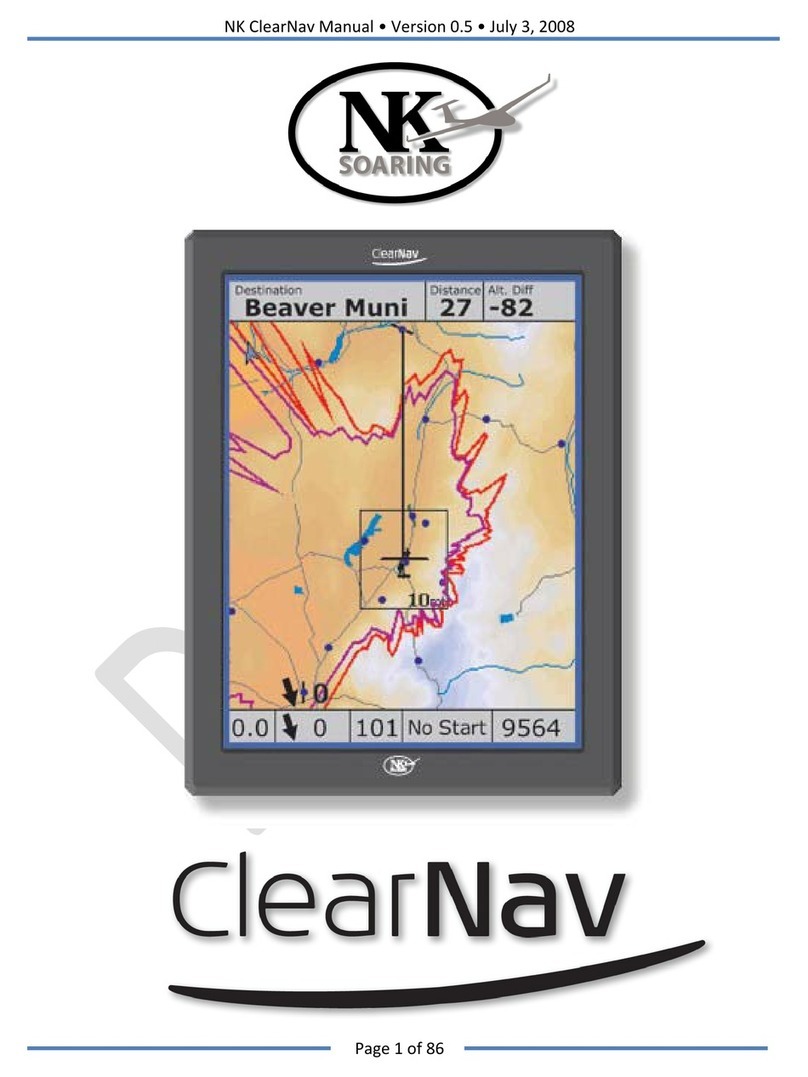Avidyne IFD440 Manual


Revision History
Revision
Date of Release
Reason for Release
00
April 2015
Initial Release of document that
coincided with Software
Release 10.1.0.0
01
July 2015
Optimizations for black and
white printing
02
November 2015
Corrected several errors and
added some additional
descriptions
03
December 2016
Update to accompany Software
Release 10.2.0.0
04
March 2017
Formatting changes to improve
printed copies
05
February 2018
Update to accompany Software
Release 10.2.1.0
06
March 2018
Added network connection
description 10.2.1.0
07
April 2019
Update to accompany Software
Release 10.2.3.1. Combined
all IFD400 series products into
one document
08
September 2021
Update to accompany Software
Release 10.3.0.2

IFD400 Series Pilot Guide
Table of Contents 1
TABLE OF CONTENTS
1System Overview...............................................................1-1
INTENDED FUNCTION.......................................................1-2
IFD440 .............................................................................1-2
IFD410 .............................................................................1-3
FUNCTIONAL OVERVIEW .................................................1-4
BASIC CONCEPTS.............................................................1-6
Page Keys........................................................................1-6
Line Select Keys..............................................................1-6
Right Knob Labeling.........................................................1-7
Color Philosophy..............................................................1-7
GENERAL IFD OPERATIONS ............................................1-9
IFD440 Bezel Layout .......................................................1-9
IFD410 Bezel Layout .......................................................1-9
Power Control ................................................................1-11
Brightness Controls........................................................1-12
Start-Up Sequence ........................................................1-13
Database Currency States.............................................1-15
Page Layout and Formats..............................................1-16
Com-Nav †.....................................................................1-18
Frequency List †............................................................1-25
Transponder Control and Display..................................1-26
Direct-To Operations......................................................1-29
Function Keys ................................................................1-31
Touch Screen.................................................................1-33
Operations With wireless Devices .................................1-36
Dual IFD Operations ......................................................1-41
SBAS vs Non-SBAS Operations....................................1-45
Interaction With External Devices..................................1-46
Before Takeoff Techniques............................................1-47
2FMS Subsystem .................................................................2-1
FPL (FLIGHT PLAN) TAB....................................................2-2
FMS Basic Concepts .......................................................2-2
Creating a New Flight Plan..............................................2-8
Previewing Flight Plans....................................................2-9
Selecting a Departure ....................................................2-10
Inserting A Waypoint......................................................2-12
Inserting an Airway ........................................................2-13
Deleting A Waypoint ......................................................2-14
Editing A Waypoint.........................................................2-15
Adding Altitude Constraints............................................2-15
Direct-To........................................................................2-16

IFD400 Series Pilot Guide
2 Table of Contents
Entering And Intercepting A Radial................................2-20
Deleting A Flight Plan ....................................................2-21
Creating A Holding Pattern............................................2-22
Circular Orbits................................................................2-23
Deleting A Holding Pattern.............................................2-25
Editing A Holding Pattern...............................................2-25
Activating a Flight Plan ..................................................2-25
Flight Plan Sequencing..................................................2-26
Lateral Offsets................................................................2-27
Flight Plan Discontinuities..............................................2-28
Enroute Descents ..........................................................2-30
Entering An Arrival and Approach .................................2-32
Visual Approaches.........................................................2-36
Activating A Leg.............................................................2-38
Use of the Map FPL Split Page .....................................2-40
INFO TAB ..........................................................................2-41
ROUTE TAB ......................................................................2-45
Creating A New Route...................................................2-46
Editing a Route ..............................................................2-46
Naming A Route.............................................................2-46
Copying A Route............................................................2-47
Inverting A Route ...........................................................2-48
Activating A Route .........................................................2-48
Deleting A Route............................................................2-49
WPT (USER WAYPOINTS) TAB.......................................2-51
Creating A User Waypoint .............................................2-51
Naming A User Waypoint...............................................2-52
Deleting A User Waypoint..............................................2-52
Designating A User Waypoint As An Airfield.................2-52
NRST (NEAREST) TAB.....................................................2-54
3Map Subsystem..................................................................3-1
MAP TAB .............................................................................3-1
Map Controls....................................................................3-2
Other Map Features.........................................................3-5
Fuel Range Rings ............................................................3-9
Decluttering The Map.....................................................3-11
Map Panning..................................................................3-11
Graphical Flight Planning (“Rubber Banding”)...............3-12
Altitude Constraints On Map..........................................3-14
Map Information Pop-Up Boxes.....................................3-14
Datalink Weather Overlays And Operations..................3-16
Datalink Radar ...............................................................3-19
Weather Overlays On Map ............................................3-21

IFD400 Series Pilot Guide
Table of Contents 3
TFR................................................................................3-25
Indications Of Data Age.................................................3-25
Traffic Display ................................................................3-26
Traffic Sensor Control....................................................3-34
TERRAIN AWARENESS...............................................3-36
Forward Looking Terrain avoidance (FLTA)..................3-38
Altitude Callout...............................................................3-40
HELICOPTER TAWS (HTAWS)........................................3-41
HTAWS Self-Test...........................................................3-42
SYNTHETIC VISION (SVS) / TAWS TAB.........................3-43
Flight Plan Display.........................................................3-44
HTAWS Control .............................................................3-46
Self-Test.........................................................................3-47
4Aux Subsystem..................................................................4-1
AUDIO TAB..........................................................................4-2
Volume Control ................................................................4-2
Satellite Radio Tuning......................................................4-4
Com Presets †.................................................................4-6
UTIL (UTILITIES) TAB.........................................................4-8
Timers..............................................................................4-8
Calculators.....................................................................4-11
Electronic Checklist........................................................4-16
SETUP TAB.......................................................................4-20
Category Structure.........................................................4-20
Item structure.................................................................4-21
Item editing ....................................................................4-21
Alerts Category ..............................................................4-24
Connectivity Category....................................................4-27
Datablocks Category......................................................4-35
Display Category............................................................4-49
FMS Category................................................................4-52
Map Category ................................................................4-57
Radio Category † ...........................................................4-62
Terrain Category............................................................4-63
Time Category ...............................................................4-65
Transponder Category...................................................4-67
Units Category ...............................................................4-68
User profile Category.....................................................4-71
Presets...........................................................................4-72
SYS (SYSTEM) TAB..........................................................4-78
Fuel Management..........................................................4-78
System Status................................................................4-80
ALERT TAB .......................................................................4-91

IFD400 Series Pilot Guide
4 Table of Contents
5Navigation...........................................................................5-1
NAV SOURCE KNOB/BUTTON..........................................5-5
OBS MODE..........................................................................5-9
VOR COURSE DEPICTION †...........................................5-12
ARMED VS ENGAGED/ACTIVE INDICATIONS...............5-13
FMS HOOKS .....................................................................5-14
COURSE CHANGES AND HOLDS...................................5-17
AUTO VLOC TUNING † ....................................................5-18
TRANSITION ALTITUDES/LEVELS..................................5-19
NAVIGATION MODE/CDI SCALE CHANGING ................5-21
APPROACH PROCEDURES ............................................5-22
Automatic mode switching †..........................................5-23
Precision Approaches....................................................5-24
Non-Precision Approaches............................................5-25
Back Course Approaches †...........................................5-25
SBAS Approaches .........................................................5-25
Visual Approaches.........................................................5-29
MISSED APPROACH........................................................5-31
RETRY APPROACH..........................................................5-33
ENROUTE VERTICAL NAVIGATION (VNAV)..................5-34
Allowing Enroute VNAV.................................................5-35
Defining the enroute VNAV altitude target.....................5-35
Defining the descent path..............................................5-36
Vertical Direct-To...........................................................5-37
Enroute Vnav Indications...............................................5-38
RECOMMENDED ICAO EQUIPMENT CODES................5-40
6General................................................................................6-1
CREW ALERTING SYSTEM (CAS) / ALERTS...................6-2
Master Caution Lamp.......................................................6-2
Alert Message Bar ...........................................................6-3
SELF TEST OUTPUT........................................................6-27
SYSTEM FAILURES..........................................................6-28
Power Distribution..........................................................6-28
Loss Of IFD....................................................................6-28
Loss Of Display..............................................................6-29
Loss Of Bezel Controls..................................................6-30
Loss Of Touchscreen Control........................................6-30
Loss Of GPS (Dead Reckoning)....................................6-31
Other Anomalies ............................................................6-32
SUBSCRIPTIONS..............................................................6-33
NIGHT OPERATIONS.......................................................6-34
IFD Display Brightness ..................................................6-34
IFD Bezel Brightness .....................................................6-34

IFD400 Series Pilot Guide
Table of Contents 5
Display Of Terrain On Map............................................6-34
HIGH TEMPERATURE OPERATIONS.............................6-34
COLD TEMPERATURE OPERATIONS............................6-36
LOW POWER OPERATIONS ...........................................6-37
HIGH POWER OPERATIONS...........................................6-38
USE OF GLOVES..............................................................6-39
CHARGING FROM THE USB...........................................6-41
INTEGRATION WITH THE IFD100 MOBILE APP............6-42
DEMO MODE ....................................................................6-43
DATA TRANSFER TO/FROM EXTERNAL DEVICES......6-46
REGULATORY COMPLIANCE STATEMENTS................6-50
Radio Regulatory Compliance Statements†..................6-50
Déclaration(s) de conformité réglementaire†.................6-51
FIS-B Weather ...............................................................6-52
MAINTENANCE MODE.....................................................6-53
Starting Maintenance Mode at power up.......................6-53
Starting Maintenance Mode from Flight Mode...............6-53
Exiting Maintenance Mode.............................................6-55
DATABASE UPDATES......................................................6-56
SOFTWARE UPDATES ....................................................6-62
DATALOGS DOWNLOAD.................................................6-63
USER DATA BACKUP/RESTORATION PROCEDURE...6-68
Saving User Data...........................................................6-68
Reloading Previously Stored User Data ........................6-69
TRANSFERRING USER WAYPOINTS.............................6-69
Uploading User Waypoints ............................................6-70
Downloading User Waypoints........................................6-71
PAIRING A BLUETOOTH®KEYBOARD...........................6-73
Verification of successful pairing ...................................6-75
CLEANING THE DISPLAY................................................6-78
SLIDE-IN REPLACEMENT DETAILS................................6-79


IFD400 Series Pilot Guide
System Overview 1-1
1 System Overview
All images contained in this manual are for reference use only,
and are subject to change.
Avidyne strongly recommends that pilots use the IFD system only
under VFR conditions until completely familiar with its operation
and use.
Boxed areas marked as NOTE within this manual identify certain
situations or areas of operation having heightened safety
implications. While it is important for the operator to be familiar
with all of the information in the manual, it is essential to the safe
use of the IFD that pilots give careful attention to the material
contained within these NOTEs.
In order to avoid a diversion of attention from the task of safely
taxiing, pilots should avoid performing the described cockpit tasks
while the aircraft is in motion on the ground. It remains the pilot’s
duty to monitor the IFD for proper function upon activation and
during use.
Internal data logs and the storage devices that record and store
data are property of Avidyne.

IFD400 Series Pilot Guide
1-2 System Overview
INTENDED FUNCTION
This manual describes the operation of the Avidyne IFD4xx series
of equipment. Not all capabilities described herein are applicable
to every model in the series. The IFD440 is the basis for
capabilities described in the manual. Differences from the
IFD440 are specifically identified throughout the manual.
IFD440
The Avidyne IFD440 is a GPS, VHF Communication, and VHF
Navigation transceiver whose primary function is to conduct VHF
communication and navigation, and serve as the primary
navigation system for all VFR and IFR VHF and GPS navigation
and instrument flying, provided it is connected to an external
navigation source selection annunciator and a CDI/HSI indicator
that is installed in the required field of view.
IFD440 Integrated Flight Display
Supplemental IFD functions include a moving-map, flight
management system (FMS), checklists, and a number of timer
and calculator types of utilities. Optional IFD functions include
control and display of remote transponders. The system includes
terrain alerting as well as an option for HTAWS.

IFD400 Series Pilot Guide
System Overview 1-3
IFD410
The Avidyne IFD410 differs from the IFD440 in that there is no
internal VHF communication and navigation transceiver. Its
primary function is to conduct GPS navigation, provided it is
connected to an external navigation source selection annunciator
and CDI/HSI indicator that are installed in the required field of
view. The IFD410 cannot be used to execute terminal area
procedures that rely on VHF navigation. The IFD410 bezel differs
physically from the IFD440 in that the radio controls along the left
side of the bezel are absent, the navigation source selection knob
is replaced by an OBS button, and the volume knob is replaced
by a single-function power on/off button.
IFD410 Integrated Flight Display
DOCUMENTATION CONVENTION
Throughout this document, capabilities that are
not applicable to the IFD410 are identified using
a † symbol.

IFD400 Series Pilot Guide
1-4 System Overview
FUNCTIONAL OVERVIEW
The Avidyne Integrated Flight Display (IFD) system supports the
following functions:
Flight Management System (FMS)
SBAS and non-SBAS GPS Navigation
VHF Communication and Navigation (16W and 10W
variants) †
Moving map, including synthetic vision view
Terrain Awareness
Forward Looking Terrain Alerting (FLTA)
Display of datalink weather
ADS-B position and display
Lightning sensor display
Traffic display
Electronic checklists
Data logging
Crew Alerting System (CAS)
Utilities (e.g. Schedulers, Timers, Calculators)
Multi-touch touch screen control
Multiple IFD operations
Remote transponder control and display
WiFi and Bluetooth®communication
The system has been designed for single-pilot IFR operation and
features a Page and Tab user interface.
Most functions revolve around the page keys that appear across
the bottom edge of the bezel. Each of the three functional pages
has associated tabs, which contain related data, often in different
views. These functions and tabs are covered in detail throughout
this reference manual.

IFD400 Series Pilot Guide
System Overview 1-5
NOTE
Global SBAS Support
Wide area/regional satellite based augmentation
system (SBAS) support provided by the IFD include
WAAS (Continental US, Alaska, Canada and most
of Central America), EGNOS (most of Europe and
North Africa), MSAS (Japan) and GAGNAN (India).
These are regional augmentations of the GPS
satellite constellation and should not be interpreted
as meaning the IFD is compatible with other GNSS
constellation systems such as Galileo (Europe),
GLONASS (Russia), or Compass (China).
NOTE
The HTAWS functions provided by the IFD are
compliant with TSO-C194.

IFD400 Series Pilot Guide
1-6 System Overview
BASIC CONCEPTS
PAGE KEYS
The buttons along the bottom of the IFD bezel are called “page
keys”. Each key is labeled by function:
FMS (Flight Management System)
MAP (Moving Map)
AUX (System Pages)
Each page has a number of associated tabs. Each page key has
a left and right rocker nature to it. Select the page of interest by
pressing either side of the page key and navigate through the
available tabs by pressing the left or right side, in the direction of
the desired tab.
Page keys
LINE SELECT KEYS
Line Select Keys (LSK), are the buttons found along the left
vertical side of the bezel. These are different from page keys in
that they are labeled on the screen, just inside the bezel adjacent
to the physical button, indicating the function of the LSK. An LSK
can either represent an action or a state.
A State LSK is identified by a title on the first row, shown in blue-
green, and the current state on the second row shown in white.
The title reflects the system function or setting to be affected, and
the state shows the current state of that setting. Pressing the
LSK or touching the label will change to the next state.
An Action LSK is identified by a phrase shown in blue-green.
The phrase is usually in verb-subject form, but there are
exceptions when the verb is omitted (e.g. "Timers"). Pressing the
LSK or touching the label will cause the system to perform the
specified action.

IFD400 Series Pilot Guide
System Overview 1-7
LSK Types
RIGHT KNOB LABELING
The bottom right dual-concentric knob on the IFD is context-
sensitive. Displayed in the lower right corner of the display, the
knob label indicates the function of the knobs and the knob button
on the left and right side, respectively. The symbol used to
represent the knob button is a ring with a center dot.
Right Knob Label Scheme
In the example above, the outer knob scrolls through a list in a
coarse manner and the inner knob scrolls through the same list
stopping at each minor field along the way. Pushing the knob
generates a drop-down menu.
COLOR PHILOSOPHY
There are a few generalities with the use of color that are
consistent across the IFD as described in the table below:

IFD400 Series Pilot Guide
1-8 System Overview
IFD Feature/Function
Color
Page keys
Green - Active
White - Available but not
currently active
Note: AUX can also be Red,
Yellow, or Cyan if there is an
active alert as described later
in this manual
FMS “Fly To” Data (e.g. active
leg of flight plan, To Waypoint
datablock)
Magenta
Active Navigation Data (e.g.
Active Com frequency, Active
Navigation frequency, Active
Navigation Source mode)
Green
Line Select Key Labels
Light Blue-Green
Line Select Key States
White

IFD400 Series Pilot Guide
System Overview 1-9
GENERAL IFD OPERATIONS
IFD440 BEZEL LAYOUT
IFD410 BEZEL LAYOUT
Com/Nav Manual
TuningKnob PageFunction
Keys
CamLatch
LineSelectKeys
Dedicated
FunctionKeys
Context
SensitiveKnob
Volume/Power/
Squelch Knob CDINav
SourceKnob AmbientLight
Sensor
Frequency
Swap
USBPort
PageFunction
Keys
CamLatch
LineSelect
Keys Dedicated
FunctionKeys
Context
SensitiveKnob
Power
Button GPS/OBS
Button AmbientLight
Sensor
USBPort

IFD400 Series Pilot Guide
1-10 System Overview
Starting in the top left corner and working counter-clockwise
around the bezel, the IFD has:
Power/Volume/Squelch knob †or Power Button *
Frequency Swap dedicated button †
Three (3) Line Select Keys (LSKs) that are page
dependent with soft key labels adjacent to each
Dual concentric rotary knob as a means of manually
tuning communication and navigation frequencies †
Mechanical cam latch access hole for installation
Page keys along the bottom
USB port for database updates, datalog downloads,
software updates, and powering USB devices in-flight
Dual concentric rotary knob that is page dependent
Four (4) dedicated function keys consisting of:
oDirect-To (“─D─>”)
oProcedure (“PROC”)
oEnter (“ENTR”)
oClear (“CLR”)
CDI Navigation Source knob †or GPS/OBS Button *
Ambient Light Sensor
*Applicable only to the IFD410

IFD400 Series Pilot Guide
System Overview 1-11
POWER CONTROL
The IFD is typically powered by two circuit breakers; one for the
VHF transceiver, and one for the remainder of the unit. The IFD
will automatically start when the aircraft bus power is applied. It
will take several seconds for the IFD to complete the power-up
process.
The power button in the top left corner can be used to turn the
unit off and to turn the unit back on again. To turn the unit off,
press and hold the button. A five second countdown will be
displayed. At the end of the countdown, the unit will be powered
off.
Manual Power Down
COOL FEATURE
Briefly pressing and then releasing the power button
is a convenient way to immediately disable
Bluetooth and networking capabilities.

IFD400 Series Pilot Guide
1-12 System Overview
BRIGHTNESS CONTROLS
Each IFD has brightness controls to control both the bezel and
the display brightness. Using the controls on the Setup Page, the
user can specify whether brightness is controlled manually, using
cockpit dimming controls, or using ambient light sensor
(photocell) that is embedded in the bezel.
Brightness Controls
Depending on how the installer configured the brightness controls
at time of installation, the “Photocell” setting will typically revert to
the dimming bus setting in low ambient light conditions.
If the IFD appears to be inoperative or non-responsive from a
lighting perspective, check the aircraft instrument lighting control
to ensure it is not set to a night position.
Other manuals for IFD440
1
This manual suits for next models
1
Table of contents
Other Avidyne Avionic Display manuals

Avidyne
Avidyne IFD550 User manual
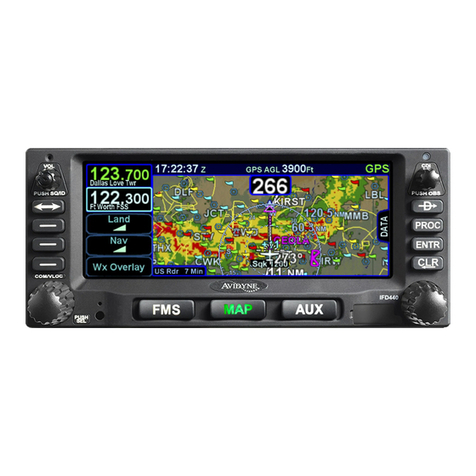
Avidyne
Avidyne IFD440 User manual
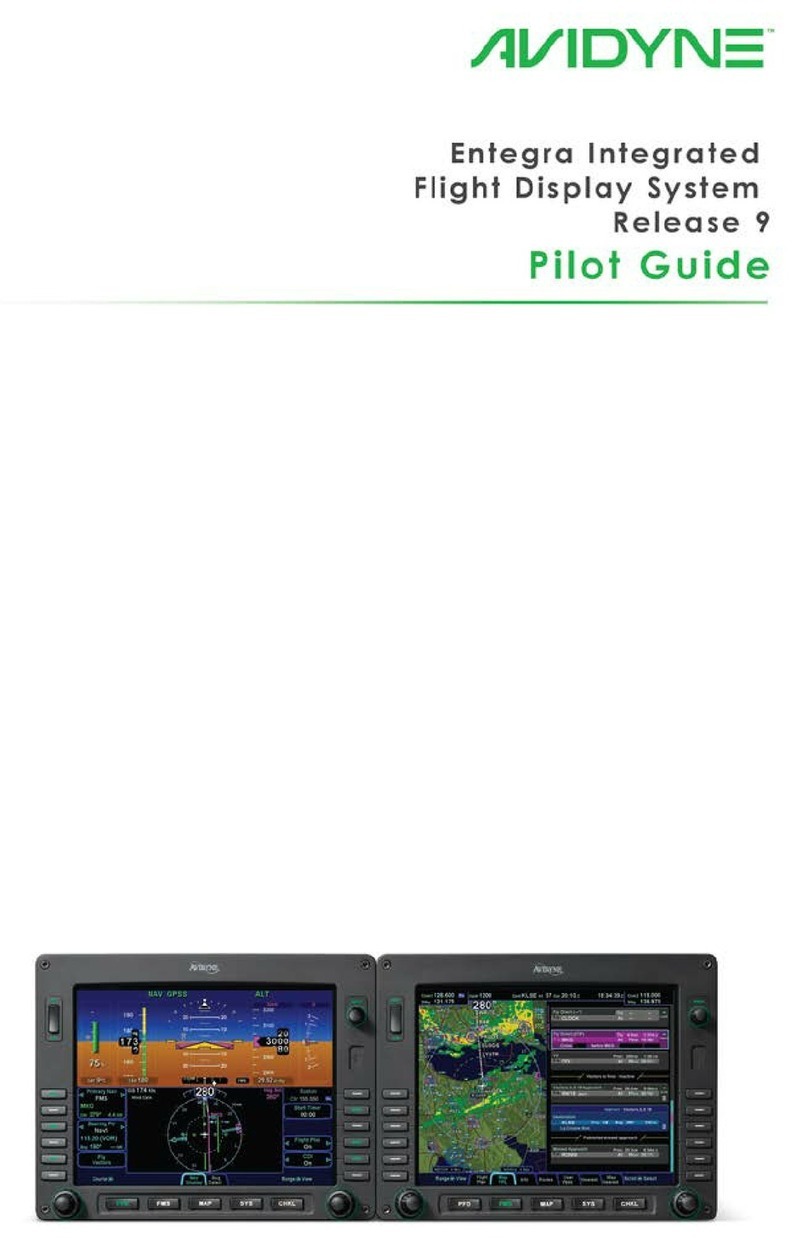
Avidyne
Avidyne Entegra Manual
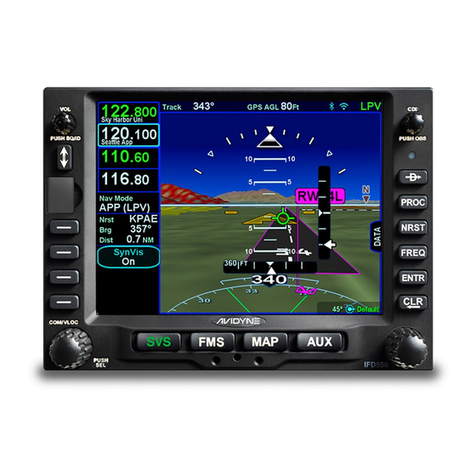
Avidyne
Avidyne IFD5 Series User manual
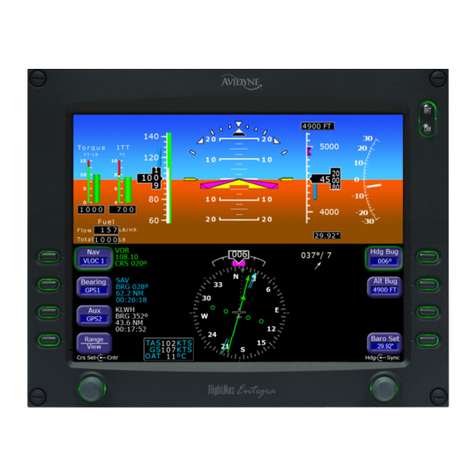
Avidyne
Avidyne Entegra EXP5000 Manual
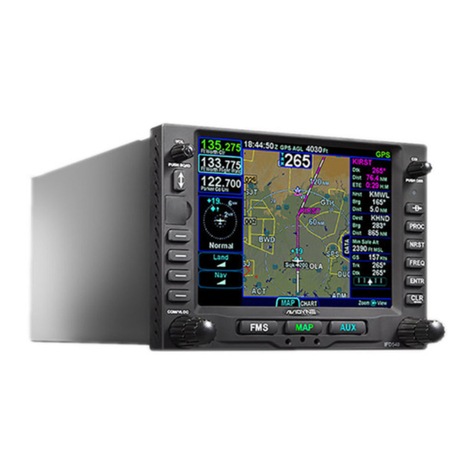
Avidyne
Avidyne 700-00182 Series Service manual

Avidyne
Avidyne Entegra EX5000 User manual
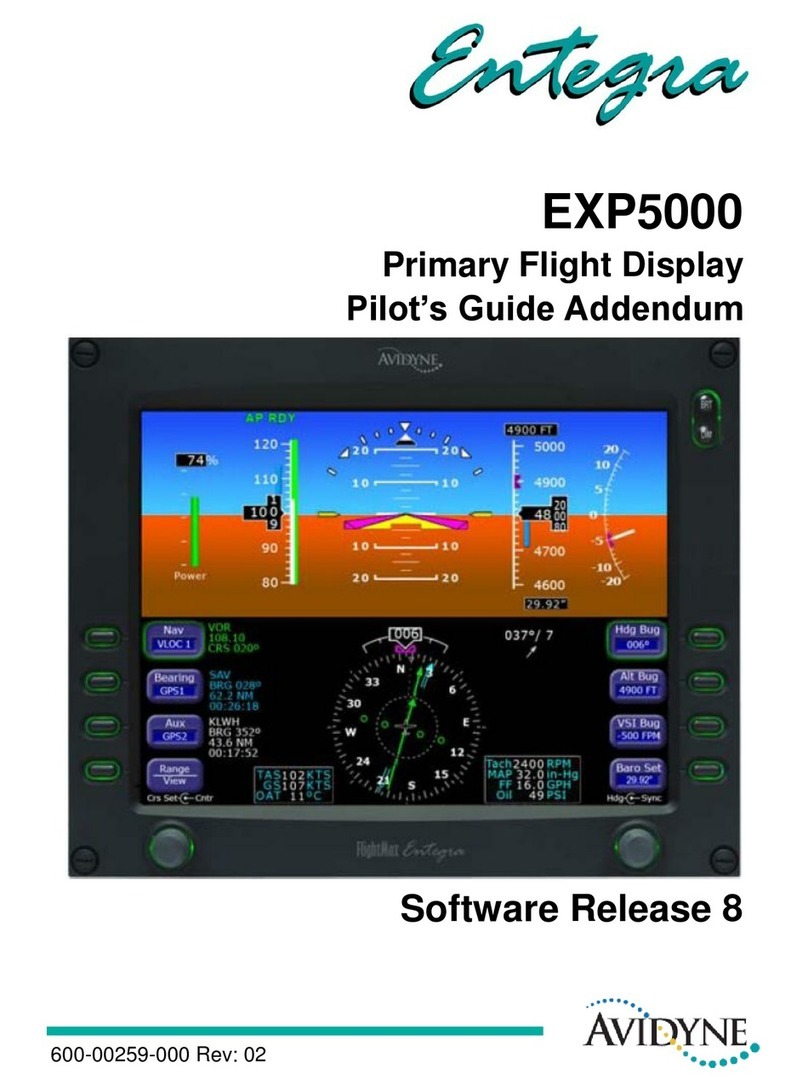
Avidyne
Avidyne Entegra EXP5000 Installation and operating instructions

Avidyne
Avidyne Envision EX5000 Manual
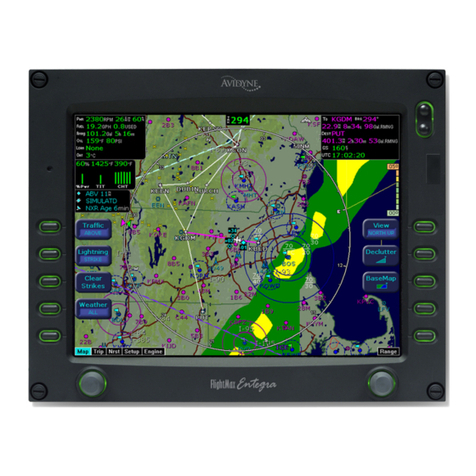
Avidyne
Avidyne FlightMax EX5000 Manual
